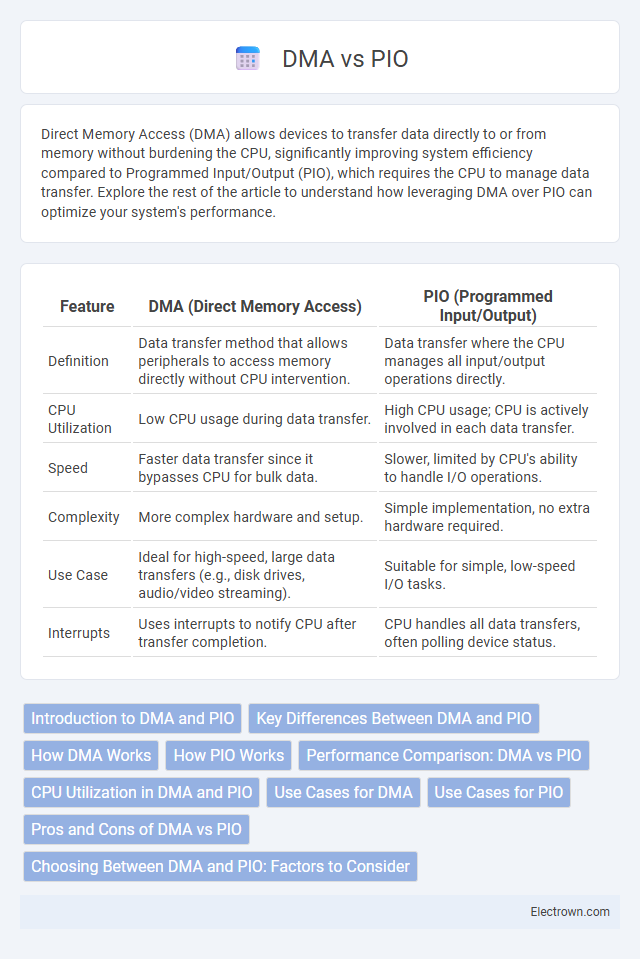Direct Memory Access (DMA) allows devices to transfer data directly to or from memory without burdening the CPU, significantly improving system efficiency compared to Programmed Input/Output (PIO), which requires the CPU to manage data transfer. Explore the rest of the article to understand how leveraging DMA over PIO can optimize your system's performance.
Table of Comparison
| Feature | DMA (Direct Memory Access) | PIO (Programmed Input/Output) |
|---|---|---|
| Definition | Data transfer method that allows peripherals to access memory directly without CPU intervention. | Data transfer where the CPU manages all input/output operations directly. |
| CPU Utilization | Low CPU usage during data transfer. | High CPU usage; CPU is actively involved in each data transfer. |
| Speed | Faster data transfer since it bypasses CPU for bulk data. | Slower, limited by CPU's ability to handle I/O operations. |
| Complexity | More complex hardware and setup. | Simple implementation, no extra hardware required. |
| Use Case | Ideal for high-speed, large data transfers (e.g., disk drives, audio/video streaming). | Suitable for simple, low-speed I/O tasks. |
| Interrupts | Uses interrupts to notify CPU after transfer completion. | CPU handles all data transfers, often polling device status. |
Introduction to DMA and PIO
Direct Memory Access (DMA) enables devices to transfer data directly to or from memory without constant CPU intervention, significantly improving system efficiency. Programmed Input/Output (PIO) relies on the CPU to manage data transfers between the device and memory, leading to higher processor overhead and slower data throughput. DMA is ideal for high-speed data transfers, while PIO suits low-speed or simple data communication tasks.
Key Differences Between DMA and PIO
DMA (Direct Memory Access) transfers data directly between memory and peripherals without CPU intervention, enabling faster and more efficient data handling compared to PIO (Programmed Input/Output), which requires the CPU to manage each data transfer. In terms of performance, DMA significantly reduces CPU overhead, allowing your system to execute other tasks simultaneously, whereas PIO involves the CPU in every data transaction, increasing processing time and limiting overall system speed. The key difference lies in DMA's ability to offload data transfer duties from the CPU, improving throughput and system responsiveness, while PIO depends on continuous CPU involvement, hindering multitasking capabilities.
How DMA Works
Direct Memory Access (DMA) transfers data directly between I/O devices and system memory without CPU intervention, using a dedicated DMA controller to handle data movement efficiently. The DMA controller manages data transfer by requesting control of the system bus, then autonomously reading from the source and writing to the destination address in memory. This process frees the CPU to perform other tasks and significantly improves data transfer speeds compared to Programmed Input/Output (PIO), where the CPU controls every byte of data transfer.
How PIO Works
Programmed Input/Output (PIO) works by having the CPU manage all data transfers between memory and peripherals directly, executing each step through a series of programmed instructions. This method ties up the CPU during I/O operations, leading to higher CPU utilization and slower data transfer rates compared to DMA. You might experience performance bottlenecks with PIO in systems requiring frequent or large-scale data transfers.
Performance Comparison: DMA vs PIO
DMA (Direct Memory Access) offers superior performance compared to PIO (Programmed I/O) by enabling hardware to transfer data directly between memory and peripherals without CPU intervention, significantly reducing CPU load and speeding up data transfer rates. PIO relies on the CPU to manage every byte of data transfer, causing higher CPU utilization and slower throughput, especially in high-volume or real-time applications. Your system will experience lower latency and greater efficiency using DMA, making it ideal for demanding tasks requiring rapid and continuous data movement.
CPU Utilization in DMA and PIO
DMA (Direct Memory Access) significantly reduces CPU utilization by enabling peripherals to transfer data directly to and from memory without CPU intervention. In contrast, PIO (Programmed Input/Output) relies on the CPU to manage all data transfers, leading to higher CPU usage and decreased overall system efficiency. Your system benefits from lower CPU overhead and improved multitasking capabilities when using DMA over PIO.
Use Cases for DMA
DMA (Direct Memory Access) is ideal for high-speed data transfer tasks such as video streaming, disk I/O, and real-time sensor data acquisition, where CPU involvement must be minimized to maintain system efficiency. It enables peripherals to directly access memory without CPU intervention, improving overall multitasking performance in embedded systems and high-performance computing. Compared to PIO (Programmed Input/Output), DMA significantly reduces CPU overhead, making it essential for applications requiring rapid and continuous data movement.
Use Cases for PIO
Programmed Input/Output (PIO) is ideal for low-speed data transfers and simple I/O operations where CPU control timing and precise data handling are critical. It is commonly used in embedded systems, small microcontrollers, and devices that require direct CPU intervention, such as older hard drives and basic peripheral communications. PIO's straightforward implementation makes it suitable for applications with minimal data throughput and simple synchronization needs.
Pros and Cons of DMA vs PIO
DMA (Direct Memory Access) offers faster data transfer speeds by allowing devices to communicate directly with memory without CPU intervention, reducing CPU load and increasing system efficiency. However, DMA requires more complex hardware support and can introduce challenges in managing data integrity and synchronization. PIO (Programmed Input/Output) is simpler to implement and provides easier control over data transfers but significantly burdens the CPU, leading to slower overall performance and higher processor utilization.
Choosing Between DMA and PIO: Factors to Consider
Choosing between DMA (Direct Memory Access) and PIO (Programmed Input/Output) depends on system performance needs and resource availability. DMA offloads data transfer tasks from the CPU, enhancing efficiency in high-speed operations and large data volumes, while PIO relies on the CPU to manage data transfers, appropriate for simpler or low-throughput applications. Your choice should consider CPU load tolerance, transfer speed requirements, and complexity of implementation to optimize system responsiveness and resource use.
DMA vs PIO Infographic

 electrown.com
electrown.com